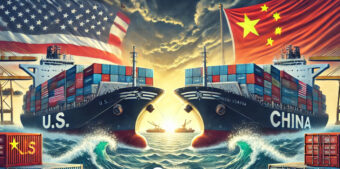This Week in Imaging: New Tariffs Up to 60 Percent May Be On the Way for Printers and Copier/MFPs

One consequence of the election of Donald Trump may be the imposition of tariffs that could range from 10 to 20 percent on all countries, and up to 60 percent on goods from China.
Importing companies would pay the tariffs, which they would then typically pass on to customers – as several U.S.company CEOs have already stated they would do in recent earnings’ calls. Many economists say these tariffs would then kick-start another round of higher inflation and interest-rate hikes.
This isn’t the first time, of course, for new tariffs. In 2018 under Trump, the U.S. imposed tariffs of 30 to 50 percent on goods imported from China, including printers, copier/MFPs, and their parts and supplies. (China then retaliated with tariffs against U.S. goods like aluminum, airplanes, cars,and soybeans.)
Some printer/copier companies like Ricoh responded by shifting their production facilities out of China. But if we get tariffs of up to 20 percent on goods for any country that would hardly matter. The end result could be tough for some companies with at least 10 percent – and maybe even 60 percent – increases on printer supplies, parts, and hardware.
Three companies do however make printers and supplies in the U.S.: Xerox, which continues to make toner at its plant in Webster, New York; Lexmark, which makes toner and photoconductors for its laser printers in Boulder, Colorado; and HP Inc.. which makes printers and supplies at its facilities in Washington, Oregon, and California. However, Lexmark could face a particular problem – it makes printers and toner in Juarez, Mexico, a country that Trump has threatened with a 25 percent tariff. (Ironically, earlier this year, the U.S. made a favorable decision for Lexmark, switching its country of origin for its printers from China to Mexico, exempting Lexmark from Chinese tariffs.) It should be noted though that all of these companies still have significant manufacturing overseas and would still be affected by tariffs.
These new tariffs could be imposed relatively quickly with executive action, with no Congressional approval required. For the printer/copier industry that’s just managed to begin recovering from high inflation rates that drove up costs for parts, supplies, and shipping, they could significantly drive up costs.
Financial News
Konica Minolta Reports Losses for First Half and Second Quarter
Difficult Second Quarter, First Half for Fujifilm Business Innovation
Epson Sees Improvement in Second Quarter, with Sales, Profit Up
Ninestar Continues to Report Upbeat Financial Results
Commercial and Production Printing
Fujifilm Expands Revoria Press E1 Series with New High-Speed Model
Office Printers and MFPs
New Kyocera A4 Models Feature Faster Print Speed, Higher Toner Yield, More
Legal Briefs
Law Firms Launch Investigations on Behalf of Xerox Investors
Hybrid and Remote Work
Study Shows Work-at-Home Doesn’t Affect Productivity
Workflow and Business Processes
ABBYY Previews New Capabilities for AI for Business Processes
Acquisitions
Thoma Bravo, H.I.G. Capital Agree to Acquire CompTIA

You must be logged in to post a comment.